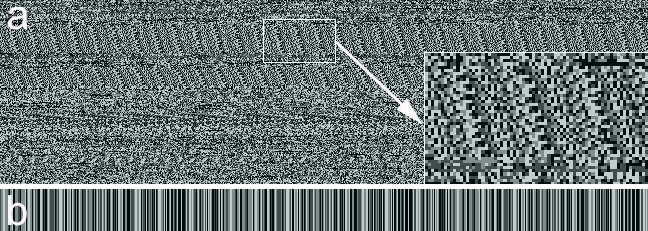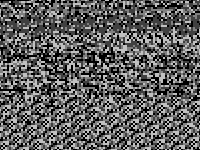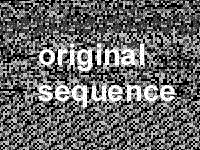THE "FUNCTIONAL ANARCHY" OF GENOMES
Guenter Albrecht-Buehler, Ph.D.
Fellow, European Academy of Sciences, Brussels
Fellow, Institute for Advanced Studies, Berlin
Robert Laughlin Rea Professor Emeritus of Cell Biology
Northwestern University Medical School, Chicago

Fig.1 Examples of the non-random sequence patterns of actual genomes depicted by the GPxI method that assigns one of
four graytone pixels to each base.
(a) The first 170 kb of the human X-chromosome(A stretch of 50 kb of un-sequenced bases are omitted). The framed section is magnified to show that the motifs in the pattern
do not repeat identically as they would in truly repetitive DNA (see panel b). Instead, they are variations of a motif.
(b) GPxImage of a computer constructed, truly periodic DNA sequence.
INTRODUCTION
It may seem quite amazing that genomes actually survived. On one hand they consist of billions of nucleotides
whose precise order needs to be replicated with uncanny accuracy for millions of years. On the other hand there
is the startlingly complex and arguably vulnerable replication mechanism of the double helix where millions of
Okazaki fragments must be synthesized and ligated in their proper order at extremely high speeds in spite of the
ubiquitous thermal noise that tosses all molecules violently around. But there are worse hazards of accurate genome
replication than thermal noise. Genomes may also be damaged severely by a barrage of scrambling mechanisms including UV- and
cosmic radiation, insertions, deletions, recombinations, transpositions, retro virus invasions, chemical interconversion,
chromosome breakage,and many more. Still, the genomes not only survived all these hazards for millions of years, they even
evolved to support more and more fantastically complex organisms.
THE CONVERSION OF GENOME HAZARDS INTO GENOME PERTURBATIONS
Today, they are well-protected by many powerful and complex repair and maintenance mechanisms. However, their main line of defense is still
the simplest and most obvious: The genomes (and their corresponding organisms) evolved the ability to reproduce faster than the hazard mechanisms
could generate mutants. This strategy turned the genome hazards into relatively harmless genome perturbations, albeit on an evolutionary time scale, which can
never create more than a small minority of deviant organisms. And these, if detrimental, will be eliminated by natural selection, while a vast majority of intact copies remains to carry
the intact genome into the next generation.
Of course, the strategy to minimize the impact of the 'enemies' by outnumbering them, did not eliminate or even weaken the hazards for the genomes. If we were able to
watch a time-lapse movie of the fate of a genome and its descendents at a rate of 1 frame per millenium or longer, we would recognize how violent the actions of countless
recombinations, deletions, virus integrations, transpositions, point mutations,...really are. In fact, we would presumably describe their effect
on the genome as outright anarchy.This kind of anarchy is illustrated below in Fig.2.

Fig.2a The GPxI of the segment between positions 85,000 and 115,000 of the human X-chromosome.

Fig.2b. The progressive destruction of the genome sequence of Fig. 2a by random point mutations
(white flashes leaving a white pixel behind),
insertions (white segments) and upstream and downstream, direct and inverted transpositions
(sequence shifts, preceeded by a temporary appearance of a white segment, where the transposon originated)
THE CONVERSION OF PERTURBATIONS INTO CREATIVE FORCES
Most astoundingly, however, accelerating their reproduction achieved much more for the genomes than merely providing a safety net that limited the effects of this anarchy. It
turned the hazards ultimately into the main creative forces of evolution, namely into the mechanisms of variation. The logic seems seductively simple. If a mutation compromised the survival of a genome, then natural selection would subsequently eliminate this genome without any major effect on the
large population of un-altered ones. On the other hand, if it amounted to an improvement of the genome and its organism then the same natural selection guaranteed that a few hundred
thousand years later every member of this species would carry the new mutation.
To be sure, creative forces are never neat and gentle. In fact, the creative forces of natural selection, seen close up, are horrifying and brutal. The same is true for
the creative forces of variation. They, too, launch 'reckless' attacks on genomes by all the mentioned and other, yet to be discovered hazards. Still, without them,
natural selection would have had no variants to act upon.
THE RESULT: AN EXQUISITELY FUNCTIONAL AND CREATIVE ANARCHY
Ultimately, there is a most perplexing aspect of these genome hazards. With the exception of UV- and cosmic radiation, most of the other hazards are self-inflicted. Indeed, natural selection
seems to have favored them for their creative powers, in spite of their destructive effects. And so, although the mechanisms of variation still do wreak havoc on genomes and create a
state of anarchy, the genomes function exquisitely well in spite of them and, to some degree, because of them, as they tame and integrate potentially
destructive agents to become powerful factors for progress and innovation. John Kenneth Galbraith (1908-2006), recognizing the very same traits in the many thousand year old
Indian history, characterized India as a "functional anarchy". Paraphrasing his brilliant and loving insight into India, I propose
to characterize genomes by the same term.
The following chapters will describe a number of cases, taken only from my own research, where randomly acting and self-inflicted genome hazards such as point mutations and transpositions yielded
amazingly structured and symmetrical genome properties. In particular, it will be shown how 'reckless' and 'indiscriminate' transpositions, inversion, base substitutions, etc. may have created

Fig. 3 The sequence of the C.elegans X-chromosome beginning around 3.8 Mb depicted by the GPxI method that assigns one of
four graytone pixels to each base.
The framed section is magnified to show that the motifs in the pattern do not repeat identically as they would in repetitive DNA (see Fig.1b).
Instead, they are variations of a motif.




